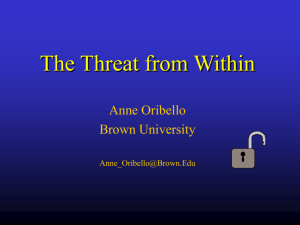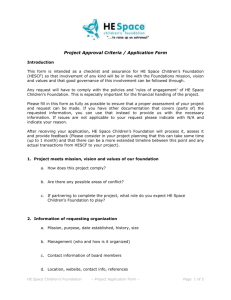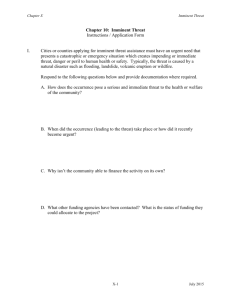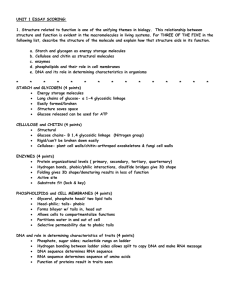class 20 fear and anxiety
advertisement
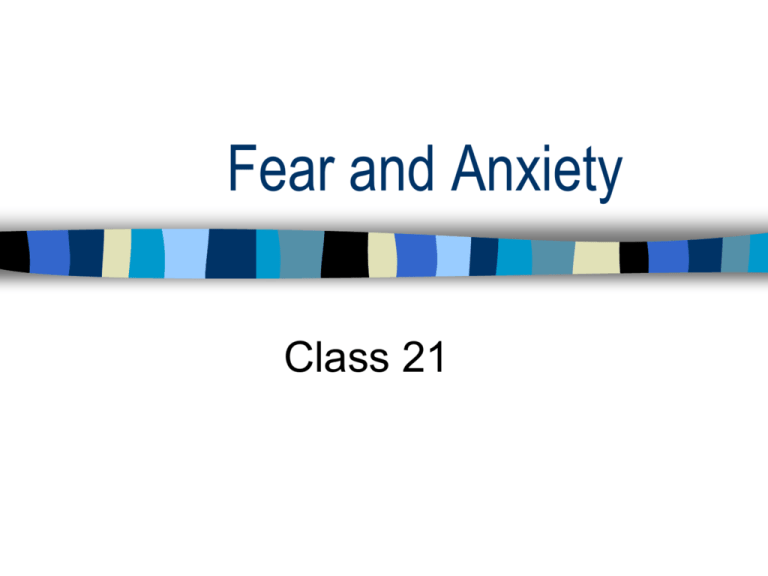
Fear and Anxiety Class 21 Final Exam Date and Time Date: Tuesday, May 14 Time: 11:45-2:45 Fear and Anxiety (Öhman Chapter) Fear Thoughts Something bad now, very soon Physiology Weak limbs, heart races, dry mouth Behavior Flee, desire to escape Timing Occurs post-stimulus Anxiety Thoughts Something bad in the future Physiology Tension Behavior Limited responses Timing Occurs pre-stimulus Classes of Fear Inducing Situations X Interpersonal Threat (rejection, ostracism, shaming) Mortality Fears (death, injury, illness, blood, surgery) Fear of animals (domestics, small ones, bugs, reptiles) Agoraphobic fear (open/closed spaces, traveling alone) Which of these is greatest fear? Evolutionary Basis for Fears Social Fears Fear of Rejection Humans prey on humans Mortality fears Humans only species aware of its own mortality Animals Predators Disease agents Agoraphobia Separation fears, lost in open space, lost in crowds “Preparedness” as Evidence of Evolutionary Basis for Fears Which is the most scary? Which is the most deadly? Tarantula Tarantula Viper Viper Rat Rat 1988 Chevy 4-door X 1988 Chevy 4-door Experimental Evidence of Preparedness (Ohman et al., 1975) UCR—Electric shock—paired with either a. Conditionion phobic: Phobic stim (photo of snake) b. Conditioning neutral: Neutral stim (photo of house) OR, c. Sensitize: Shocks only, but no pairing OR, d. Control: Photos only, no shocks MEASURE: Skin conductance response (SCR) QUESTION: How long for conditioned response (CS) to extinguish (SCR lower) due to expt. condition (a-d)? Extinction Rate of Conditioned Fear, When UCS (Pain) Paired with Phobic or Neutral Stimuli Phobic Stims (snakes) Neutral Stims (houses) 0.7 0.7 0.6 0.6 0.5 0.5 0.4 Condition 0.4 Sensitize CS Alone 0.3 0.3 0.2 0.2 0.1 0.1 0 0 5 lo c B k lo c k 4 3 B B lo c k 2 k lo c B B lo c k 1 Block 1 Block 2 Block 3 Block 4 Block 5 Phun With Phobias 1. Chaetophobia Fear of hair 2. Ephebophobia -- Fear of youths 3. Coulrophobia Fear of clowns 4. Ergasiophobia Fear of work 5. Gymnophobia Fear of nudity 6. Parakavedkeatriaphobia Fear of Friday 13 7. Neophobia Fear of newness Stigma: Where fear, anger, and humor intersect Stigma—from “Stigmata”, a mark Who are the stigmatized? Those who violate social norms: Old, infirm, disfigured, disabled, social outcast, criminal, “the other” Reactions to the stigmatized? Fear, anger, fascination, disgust, interest, anxiety, derision Why the Strong Reactions to the Stigmatized? Learned : e.g., parents to young Inborn : part of evolutionary make-up a. Strong attack weak in hierarchical species b. Immediate fear and loathing to dead animals Reactions of Chimps to the Dead and Disabled Reactions to anesthetized chimps (Hebb & Thompson, 1954) Reactions to paralyzed chimps (Goodall, 1971) Emotional reactions? Fear, anger, disgust, distain Are responses to stigma always negative? Compassion: Some chimps adopted the polio victims Fascination: Curious about people, who violate norms. a. “Freak shows” b. Tourists to East Village Admiration: a. Glamour of the rebel, bad boy/girl b. Respect for courage—Helen Keller Ambivalence: Emotions that go strongly in two directions at once—uncomfortable and powerful. Stigmatized: Hyper-visible and invisible Hyper-visible: Staring at the handicapped (Langer, et al. 1976) Invisibility and being stigmatized? Invisibility: People try to not see the stigmatized I am invisible, understand, simply because people refuse to see me. … it is as though I have been surrounded by mirrors of hard, distorting glass. [People see] only my surroundings, themselves, or figments of their imagination—indeed, everything and anything except me. Ralph Ellison, Invisible Man Panic Attacks: Characteristics * Place people is full-blown terror mode * Powerful sense of foreboding, fear, dread * Physiologically arousing: heart, breathing, etc. * Mental readiness for danger: Planning escape Panic Attacks: Causes 1. Biologically-oriented: spontaneous, arise from bio-chemical misfiring 2. Psychologists: precipitating thoughts and events, especially separation-related: family strife, job-loss 3. Attack requires: a. symptom sensitivity + b. catastrophic cognitions + c. preceding/concurrent negative events 4. Patients complain about meaning of panic 5. Panics are a vicious cycle: arousal --> cognitions --> arousal How to manage panic attacks 1. Attacks last from 15-30 minutes 2. Knowing this allows people to wait it out Hearing and Not Hearing Danger Signals: December 7, 1941 Signal Detection: Where to err? Danger Present Danger Not Present Sound Alarm Hit False Positive Don’t Alarm False Negative Hit X Why Humans “Favor” False Alarms Humans faced signal detection dilemma for millennia Evolved in a highly dangerous world Evolutionary lessons “learned” by psyche are that: 1. Defenses must activate quickly 2. Must activate at hint of threat, not at certainty 3. Threat registered with minimal cues Le Doux's "Fear Loop": Direct link: auditory nuclei to amygdala. Bypasses thalamo-cortical path. Threat doesn’t require high-level analyses Problem of Attention 1. Where to point the "radar dish", to best detect threat? 2. Timing: How do look at the right place AT THE RIGHT TIME to find threats? 3. How do we do anything else, if we're focusing only on threat? Automatic vs. Controlled Info. Processing Automatic Controlled Gross characteristics Fine characteristics Unconscious, voluntary Conscious, directed Can’t suppress/distract Can suppress/distract Parallel (several modes at once). Sequential (only one mode at a time). Does not require effort Effortful Can’t be observed by self Can be observed by self (introspection). Automatic Processing and Threat Detection Automatic, non-conscious mental activity gives us early warning system for detecting threat Implication: You can know and not know something at the same time--not know it consciously, know it unconsciously Ohman studies: show how this occurs Basic technique: Backward masking Backward Masking 1. Present picture of threatening stimulus very quickly (30 miiliseconds) 2. Immediately after threat pix is shown, show a nonthreatening picture. The second picture is a mask, blocks first picture from consciousness. 3. Reaction to first (masked) picture indicates unconscious processing Automatic Processing of Fearful Stimuli (Ohman & Soares, 1994) 1. Pre-select: Snake phobic, not spider phobic Spider phobic, not snake phobic Have no fear of spiders or snakes 2. Targets: photos of snakes, spiders, flowers, mushrooms 3. Masks: Cut-up/reassembled target photos 4. Show target photo for 30 milliseconds. 5. Show mask for 100 milliseconds 6. Later, show target without mask 7. Outcome measure: GSR—a measure of anxiety. 8. All subjects exposed to photos of snakes, spiders, flowers, mushrooms in masked and, later, un-masked condition. Skin Conductance Level Automatic Processing of Fearful Stimuli: Results of Masked Stimuli Only 0.4 0.3 Snakes Spiders Flowers 0.2 0.1 0 Snake Phobic Spider Phobic Control Anxiety Primes Attention to Anxious Stimuli Subjects: Trait anxious vs. normal controls Auditory shadowing task * Attended ear – listens to story * Dis-attended ear -- threat words (kill, hate, disease) -- Neutral words (juice, table, leaf) Visual probes: Press “J” for names, “F” for foods Question: RT for vis. probes affected by threat/neutral words? Reaction Time to Visual Prompts Idealized Results of Shadowing Study 0.4 Threat Words Neutral Words 0.3 0.2 0.1 0 Anxious Controls Implication: Trait anxiety heightened sensitivity to threat.


